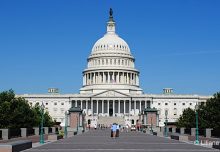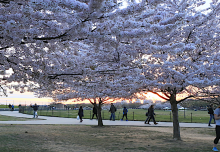Anchoring the west end of the National Mall, the Lincoln Memorial is one of the most beautiful, powerful, and inspiring monuments in the United States. It attracts more than 5 million visitors per year.
When thinking of the memorials and monuments of Washington, D.C., “classic Greek temple” may not be what immediately comes to mind. However, the Lincoln Memorial and its towering doric columns are so ingrained in American culture that it hardly seems out of place.
At 99 feet tall, 190 feet wide, and 119 feet deep, it’s impossible to overlook it from the Mall. The shallow reflecting pool stretching more than 2,000 feet in front further enhances your approach.
Walking toward the Lincoln Memorial, the first noticeable features are the 36 fluted doric columns that surround the exterior, representing each state in the Union at the time of President Lincoln’s death. These 36 states are inscribed on the frieze—the area above the colonnade—along with the other 12 states that joined the Union prior to the memorial’s 1922 dedication.
Climbing the 87 steps from the reflecting pool invokes almost as much history as the monument itself. It was on these very steps that Dr. Martin Luther King Jr. made his famous “I Have a Dream” speech in 1963. (An inscription where Dr. King stood memorializes the speech. It’s on the landing 18 steps below the memorial.) These steps have since been the location for innumerable rallies, protests, speeches, and movie settings.
On the wall of either side chamber is a different speech—the Gettysburg Address to the south and the president’s second inaugural speech to the north—topped by stunning murals. These particular speeches were selected to emphasize President Lincoln’s greatest achievements. The Gettysburg address, along with being his most-well-known speech, spoke of not just ending the Civil War, but also resuming the path set forth by those who created the United States of America four score and seven years prior. Likewise, in the president’s second inaugural address, given a mere 36 days before the end of the Civil War, Lincoln implored the still-broken nation to rejoin and accept each other “. . .with malice towards none; charity for all.” These two speeches helped to stitch a wounded America and illuminate a path toward healing.
The Lincoln Memorial is an exceptionally popular tourist attraction, but it is something everyone must see and reflect upon. If the soaring Washington Monument is the icon of D.C., the Lincoln Memorial is its soul, radiating inspiration through staggering architectural achievement and memories of what great leaders are capable of.
For all there is to see and do in Washington, D.C., pick up a copy of The Unofficial Guide to Washington, D.C. by Eve Zibart, Renee Sklarew, and Len Testa. If you enjoyed this post, sign up for our newsletter here.











